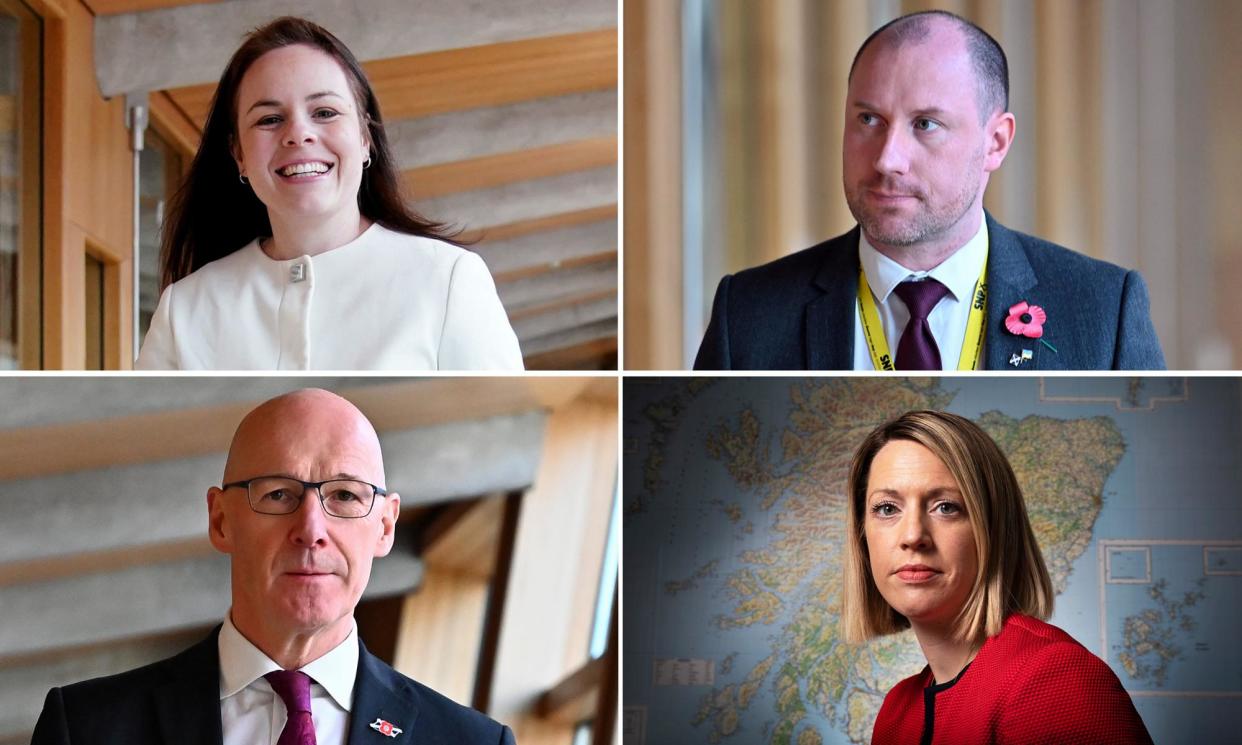Who is in the running to replace Humza Yousaf as SNP leader?

Any contest to replace Humza Yousaf will present the Scottish National party with a significant problem: it has very few contenders with the experience and profile voters would expect to lead the Scottish government.
John Swinney
A former SNP leader and Sturgeon’s trusted deputy first minister, Swinney, 60, has said he would be a reluctant candidate but knows he would probably be the most favoured by the party’s mainstream members because of his long experience and track record as a bipartisan, shrewd and centrist figure.
Also touted as a possible interim leader, Swinney embraced his retirement as a cabinet minister when Sturgeon quit last year, to spend more time with his wife and son. It is said he would only stand as the unity candidate, without facing a bitter contest. He may well be more able than Kate Forbes (see below) to command a majority at Holyrood and to win support from the Greens.
He served briefly as SNP leader from 2000, taking over after Alex Salmond unexpectedly quit, until Swinney resigned in 2004 after his internal critics rallied against him after a poor European elections result.
An infrequent participant at Holyrood since he stood down from government, Swinney has remained loyal to Sturgeon during the crisis with her arrest by police investigating the SNP’s finances. He regularly stood at her side when she spoke to reporters at Holyrood.
Swinney, who joined the party when he was 15 and has served in several roles including leader, is a vastly experienced politician and understands the mechanics of government and the dynamic between Holyrood and the UK government, better than anyone else in the Scottish parliament. He also understands the internal dynamics and historic loyalties of SNP politicians and membership.
He is a seasoned negotiator, garnering plaudits for his protracted negotiations with Westminster after the Smith commission, which gave further powers to Holyrood after the 2014 independence referendum.
Swinney is considered the ultimate “safe pair of hands” within the party, known for his quiet charm as well as his steeliness.
Kate Forbes
Given the speed and unexpected nature of Yousaf’s leadership crisis, there has been little time for serious competitors to emerge, with the sole exception of Kate Forbes, his closest rival in last year’s leadership contest.
Forbes, 34, a socially conservative former finance secretary and a Gaelic-speaker based in the west Highlands, came within a hair’s breadth of winning the party leadership after Nicola Sturgeon resigned in February 2023. Forbes, who was critical of Sturgeon’s stance on gender recognition, North Sea oil and economic policy, lost the contest to Yousaf by 48% to 52%.
Given the Scottish government’s subsequent crises with the Scottish Greens over tax policy, climate, gender recognition, bottle recycling and Sturgeon’s wider centre-left policy agenda, Forbes would be the favourite to win – assuming Swinney was not in the running. However, her often vociferous opposition to the Greens has alienated her on the party’s left, and makes it highly unlikely the Greens would readily back the SNP’s minority government at Holyrood.
Although that diminishes her broader credibility, Forbes has been very careful to avoid controversy or suspicions that she is courting SNP members as a future leader, and was one of the first to rally behind Yousaf when the Scottish Greens crisis erupted last week. That leaves her hands clean, and for her supporters it makes her the perfect candidate.
Neil Gray
Scotland’s health secretary, Gray, is often tipped as a future party leader. An affable and pleasant mannered Orcadian, who once represented Scotland as a 400m runner, the 38-year-old is widely liked but is relatively inexperienced.
He has been an MSP since May 2021, succeeding the veteran ex-minister and Salmond ally Alex Neil as MSP for Airdrie and Shotts after quitting as an MP to stand for Holyrood.
A Sturgeon loyalist, Gray first served as a culture minister under Sturgeon before joining Yousaf’s first cabinet as economy secretary. After a reshuffle in February 2024, forced by Michael Matheson’s resignation over a scandal with a £11,000 data roaming bill, Gray replaced Matheson as health secretary – arguably the most challenging of policy portfolios.
Jenny Gilruth
An MSP since 2016, Gilruth, 39, has been a minister since 2020, first serving on the culture desk then as minister of transport, before being appointed education secretary in Yousaf’s first cabinet in March 2023.
Married to the former Scottish Labour leader Kezia Dugdale, who became her partner while in post, Gilruth is seen as very loyal to Sturgeon and her legacy.
Other possible candidates
The pool of candidates is heavily limited by the fact an SNP leader is, by convention, also Scotland’s first minister. That rules out any MPs such as the party’s Westminster leader, Stephen Flynn, the MP for Aberdeen South.
The Scottish government’s most experienced cabinet secretary, Angus Robertson, a former SNP Westminster leader, is not likely to stand. He was heavily tipped in the days after Sturgeon quit last year but, with very little overt support emerging from his colleagues, quickly ruled himself out on family grounds.


